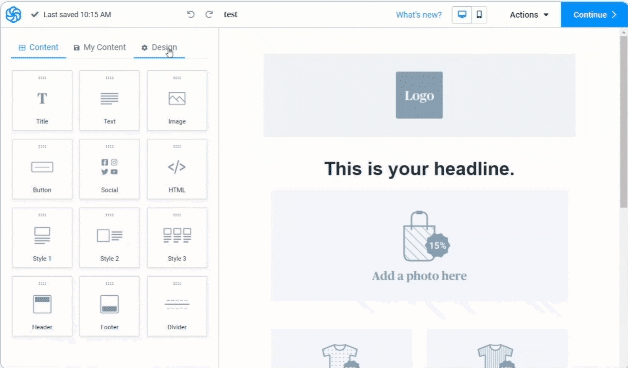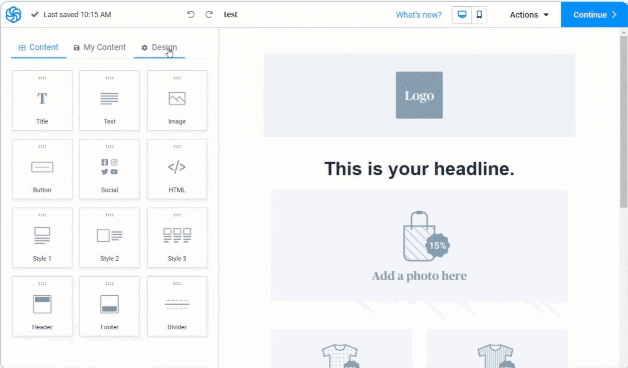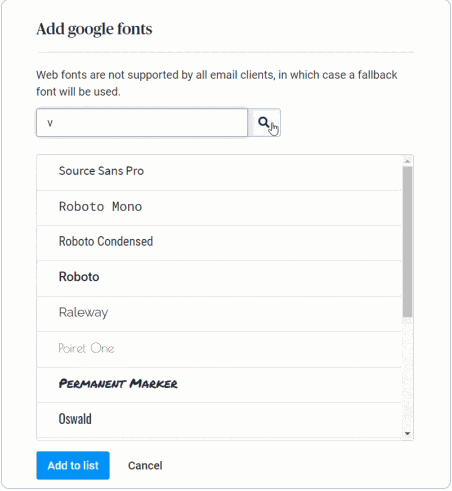

You likely spend time and effort on your email design. But what about your email font? Have you ever wondered, “What’s the best font for email?”
In email marketing, choosing the right font isn’t difficult, but it does require some careful consideration.🤔
The last thing you want is to spend hours crafting your email copy only for it to be unreadable or give a poor impression of your brand.
Typography plays a key role in the look and feel of your email. It’s a powerful tool when it comes to capturing and holding the reader’s attention.
With such a wide selection of fonts out there, choosing the best email font may seem overwhelming at times.
In this guide, we’ll explain the different font families and font styles out there. As well, we’ll give you our recommendations on how to choose one that does justice to your brand image and drives home your message. 🚀
Elements to Consider When Choosing the Best Email Font
Your company’s branding
Typography is an important aspect of your brand image and the impression you give your contacts. You want to choose a font that accurately reflects your brand voice, aesthetic, and the professionalism of your business. 🗣️
You may be thinking, “It’s just a font… What’s the big deal?” Font choice is so important to brand image because fonts convey meaning too. (Albeit more subtly than the email copy itself).
Sticking to just a few fonts or even a single one for business emails helps keep your brand’s communications familiar and professional in the eyes of subscribers and customers.
For example, if your tone is formal and serious then you should avoid novelty fonts. If your brand image is more playful and friendly, then experimenting with more custom fonts may be a good choice. 🎨
Readability & legibility
Your font should be suitable for scanning and skimming on screens of all sizes (desktop, mobile devices, and tablets). Your subscribers’ inboxes are likely flooded with email marketing content. So if the typeface you choose for your email is too hard to read, it’s likely that your audience won’t make an effort to read your email. 🤦♀️
For this reason, legibility and readability are main considerations to make when choosing an email font. Try staying away from overly ornate email fonts, as they can be more difficult to read and can sometimes lead to display issues with certain email clients. Considering the spacing between the letters is important too.
As well, it’s typically a good idea to stay away from cursive and italicized fonts, as they can be particularly hard to read on mobile devices. 📱
Neutrality
The best email fonts are ones that are neutral and blend in harmoniously with the other aspects of your content. After all, you don’t want to draw attention away from your CTAs or other important buttons.
The right font should match your brand image, but shouldn’t draw a lot of attention to itself. Readers don’t have the time to be thinking deeply about the typography of your business emails. The font you choose shouldn’t be remarkable. Instead, it should leave readers with an unconscious positive impression of your brand.
Email Font Families and Font Styles Explained
Serif and sans-serif fonts
Before we go any further, now’s a good time to explain two font styles: serif and sans-serif. ‘Serif’ means that there is a little tail at the end of each letter. ‘Sans-serif’ means ‘without a tail’. 🐒
Take a look at the example below. On the left, the font is serif. (It’s got little tails attached to the longer strokes.) On the right, it’s sans-serif font.


Next we’ll cover the three main font families: web-safe fonts, web fonts and monospace fonts.
Web-safe fonts
Also known as standard fonts or cross-platform fonts, these are the fonts that are recognized globally across all devices and email providers. For this reason, they can also be referred to as “email-safe fonts.” 📧
Pros of web-safe fonts:
Accessibility: A web-safe font is the safest bet if you want your email font to show up exactly as intended in subscribers’ inboxes. It’s the type of font that’s most widely supported across devices and email clients.
Another bonus: The email is also likely to load faster as the font is already available in the operating system.
Cons of web-safe fonts:
The selection is limited and already used across a large number of marketing emails and websites, leaving little room for originality. You may find some of these fonts don’t fully embrace the spirit of your business.
Discover Sendinblue’s collection of Web Safe fonts
When you use Sendinblue, you can choose from the following selection of popular fonts. If the font you’re looking for isn’t listed here, don’t worry. We’ll explain how to add additional email fonts in the next section.
Serifs


Formal yet versatile, Georgia has been used for screen display since it was released by Microsoft in the 1990s. Frequently used in online newspapers and magazines, it’s great for reading long passages of text on a screen.
It offers a dignified, yet accessible way to present your content to subscribers. For this reason, it’s safe to say Georgia is one of the best fonts for email.


Commonly used in printed publications like books and newspapers, Times New Roman is both classic and practical. It’s traditionally been the go-to font for academic writing. However, it’s often preferred in printed content than digitally. For shorter passages of text, this isn’t typically a problem though.
Because it’s been so widely used and was seen as the default formal typography in the early 2000s, it has recently come to be seen as slightly outdated. That said, Times New Roman can still work for branding and email marketing. Try pairing with some creative visual content to create a juxtaposition of new and old. ✨


Known for its elegance and sophistication, Palatino is commonly used in books because it’s ideal for reading long passages. Its thin strokes can give text an elevated appearance while keeping things easy to read.
Sans-serifs


Verdana ranks high in terms of readability as it is one of the most easily used web-safe fonts. In fact, it was designed specifically for on-screen text. Verdana is easy to read, simple, and highly functional as it can be used for any on-screen purpose.


The letters of Trebuchet MS have subtle curves that give the font a decorative and artistic feel. Trebuchet MS is an established web-safe font that will add style to your text. But be wary of using it for long passages as the decorative features can become difficult to read after a while.


Arial is known for being contemporary, modest, and versatile. It’s used across all types of documents both online and printed such as newspapers, magazines, reports, advertising, etc.
Arial is one of the most standard and widely used computer fonts. Some would even say ‘over-used,’ meaning it can sometimes be seen as bland and boring. If it’s originality you’re after, then it may not be the best email font for you.


Arial Black is simply the bold version of Arial.


Designed especially for screen use, Tahoma is highly versatile. One of its strongest points is that it maintains readability regardless of font size, meaning it can be used for both headings and small blocks of text.


In the Comic Sans font, each letter is clearly distinguished from the others which makes this a great font for people with dyslexia.
Although largely considered outdated and unattractive to look at, this is still a useful font if you are writing for fun or want to come across as playful.


Lucida works for both print and on-screen documents. Classic and sophisticated in appearance, this font is popular for websites.


Impact works well for headlines, taglines, or any short combination of words. Because of its tight spacing and bold typeface, it’s not suitable for long passages of text.
Web Fonts
Web fonts are specifically designed and licensed for use on websites, examples include Google Sans and Roboto.
While very commonly used in website design, web font is still a bit experimental when it comes to HTML email.
The intended font will only display in the recipient’s email if it’s compatible with their email service provider.
Web fonts are great if you know what email providers your recipients use. If the web font is incompatible, they will be shown the email provider’s default font, or a fallback font that you specified when designing the email.
One way to get around this is to use the desired web font in an image – but never send an image-only email. Emails composed entirely of images pose problems such as taking too long to load and being inaccessible to screen readers. Only use this option for small pieces of text, i.e., avoid large images with too many pixels. 🙅♀️
Pros:
The variety of web fonts is much greater than web-safe fonts. You have the flexibility to choose an attractive font that’s on-brand, shows personality and adds to the overall brand experience. 🧑🎨
Cons:
Not accepted everywhere: Web Fonts are only sure to display correctly with certain email providers (Apple mail, iOS Mail, Outlook app, Google Android (default email client, not the Gmail app), Outlook for Mac, Thunderbird, and Samsung Mail).
While Web Fonts are on the rise, they’re not going to be 100% suitable for bulk email campaigns until the day all email providers recognize them.
Monospace fonts
Monospace fonts are essentially typewriter fonts. The letters and characters occupy the same amount of horizontal space.
Sendinblue offers one Monospace font: Courier New, which is similar to Times New Roman but with equal letter spacing.
Pros:
They’re great for giving your email a minimalistic feel.
Cons:
Words take up more space as a result of the fixed character width. Not suitable for long passages or blocks of text as characters tend to blend together, making the text harder to read.
In addition, Monospace fonts don’t display for all email providers. If you’re dead set on using a monospace font, consider adjusting the line spacing of your body copy to make the content as easy to read as possible.
How to Choose the Best Email Font
When it comes to choosing the best font for your emails, we recommend you choose from one of the following two options:
Choose a web safe font that’s readable and fits your brand as closely as possible
It may not match your brand tone and personality exactly but the selection is varied enough that you should be able to reach a relatively close fit.
The advantage, of course, is that your font is going to show up exactly as intended for ALL your recipients.
Using the same font for both header and body guarantees a seamless design but that’s not to say you can’t combine fonts when they go well together. For example, it’s common practice to combine a sans serif header with a serif body text.
Choose a web font but set a web-safe fallback font (just in case!)
Select a web font that matches your brand perfectly but set a web-safe fallback font as your backup. This way you’re covered if the first-choice web font isn’t compatible with your recipient’s email provider.
Good to know: Sendinblue gives users the option to add both web fonts and fallback fonts when designing emails in developer mode.
How do I add a web font link to an email on Sendinblue?
The easiest way to add web fonts to your email campaigns with Sendinblue is in the drag and drop editor.
First, go to the “Design” tab in the left-hand menu of the editor. Next, open the “Text Appearance” submenu.


There, you’ll be able to search for and select the Google font of your choice. Once you’ve chosen the best font for your email, click “Add to list.”


The font will now appear in the pop-up menu bar in the drag and drop editor.
Find the Best Email Font for Your Brand
Never underestimate the power of typography when it comes to getting a message across effectively. 📝
It’s time to take what you’ve learned and choose the best email font for your marketing emails – or perhaps update your current font to something that suits your brand better.
Doing so with Sendinblue is quick and easy. Try saving your preferred fonts in a template so that you’re ready to go every time you create an email marketing campaign.
The drag and drop editor on the Sendinblue platform is a great place to experiment with different fonts. Once you’ve opened an account, you can send up to 300 emails a day for free. Perfect for those just starting out with email newsletters and marketing.
Jumpstart your email marketing strategy with SendinblueFree plan includes access to all core email features, unlimited contact storage, 40+ email templates, and customizable signup forms to grow your email list. |
 Deutsch
Deutsch




















